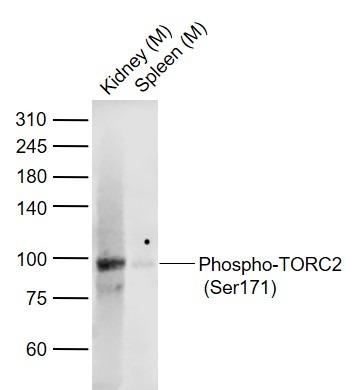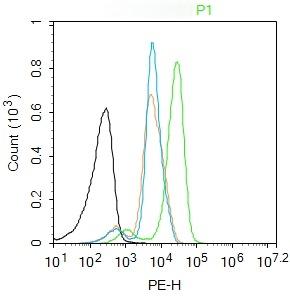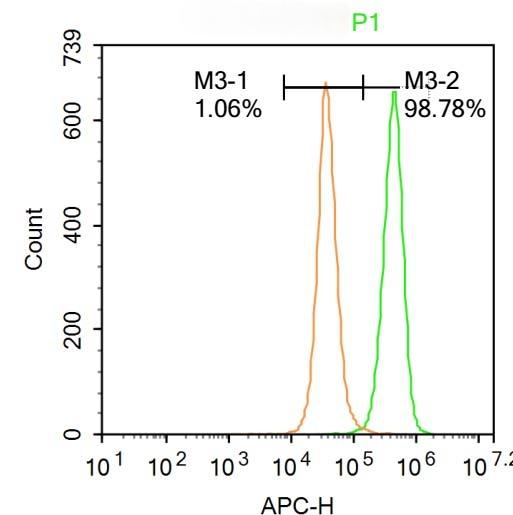Shopping Cart
Remove All Your shopping cart is currently empty
Your shopping cart is currently empty
Anti-Phospho-TORC2 (Ser171) Polyclonal Antibody is a Rabbit antibody targeting Phospho-TORC2 (Ser171). Anti-Phospho-TORC2 (Ser171) Polyclonal Antibody can be used in FCM,WB.
| Pack Size | Price | USA Warehouse | Global Warehouse | Quantity |
|---|---|---|---|---|
| 50 μL | $220 | 7-10 days | 7-10 days | |
| 100 μL | $372 | 7-10 days | 7-10 days | |
| 200 μL | $528 | 7-10 days | 7-10 days |
| Description | Anti-Phospho-TORC2 (Ser171) Polyclonal Antibody is a Rabbit antibody targeting Phospho-TORC2 (Ser171). Anti-Phospho-TORC2 (Ser171) Polyclonal Antibody can be used in FCM,WB. |
| Synonyms | Transducer of regulated CREB protein 2, Transducer of regulated cAMP response element-binding protein(CREB) 2, Transducer of regulated cAMP response element-binding protein 2, Transducer of regulated cAMP response element-binding protein, Transducer of CREB protein 2, TORC2 (p-Ser171), TORC2 (p-S171), TORC-2, RP11-422P24.6, p-TORC2 (Ser171), p-TORC2 (S171), CRTC2, CREB regulated transcription coactivator 2 |
| Ig Type | IgG |
| Reactivity | Human,Mouse (predicted:Rat,Dog,Pig) |
| Verified Activity | 1. Sample: Lane 1: Kidney (Mouse) Lysate at 40 μg Lane 2: Spleen (Mouse) Lysate at 40 μg Primary: Anti-Phospho-TORC2 (Ser171) (TMAB-01524) at 1/1000 dilution Secondary: IRDye800CW Goat Anti-Rabbit IgG at 1/20000 dilution Predicted band size: 90 kDa Observed band size: 95 kDa 2. Blank control: Jurkat. Primary Antibody (green line): Rabbit Anti-Phospho-TORC2 (Ser171) antibody (TMAB-01524) Dilution: 2 μg/10^6 cells; Isotype Control Antibody (orange line): Rabbit IgG. Secondary Antibody: Goat anti-rabbit IgG-FITC Dilution: 1 μg/test. Protocol The cells were fixed with 4% PFA (10 min at room temperature) and then permeabilized with 90% ice-cold methanol for 20 min at-20°C. The cells were then incubated in 5% BSA to block non-specific protein-protein interactions for 30 min at room temperature. Cells stained with Primary Antibody for 30 min at room temperature. The secondary antibody used for 40 min at room temperature. 3. Blank control: A431. Primary Antibody (green line): Rabbit Anti-Phospho-TORC2 (Ser171) antibody (TMAB-01524) Dilution: 1 μg/10^6 cells; Isotype Control Antibody (orange line): Rabbit IgG. Secondary Antibody: Goat anti-rabbit IgG-AF647 Dilution: 1 μg/test. Protocol The cells were fixed with 4% PFA (10 min at room temperature) and then permeabilized with 90% ice-cold methanol for 20 min at-20°C. The cells were then incubated in 5% BSA to block non-specific protein-protein interactions for 30 min at at room temperature. Cells stained with Primary Antibody for 30 min at room temperature. The secondary antibody used for 40 min at room temperature.    |
| Application | |
| Recommended Dose | WB: 1:500-2000; FCM: 1ug/Test |
| Antibody Type | Polyclonal |
| Host Species | Rabbit |
| Subcellular Localization | Cytoplasm. Nucleus. Note=Translocated from the nucleus to the cytoplasm on interaction of the phosphorylated form with 14-3-3 protein. In response to cAMP levels and glucagon, relocated to the nucleus. |
| Tissue Specificity | Most abundantly expressed in the thymus. Present in both B and T-lymphocytes. Highly expressed in HEK293T cells and in insulinomas. High levels also in spleen, ovary, muscle and lung, with highest levels in muscle. Lower levels found in brain, colon, hear |
| Construction | Polyclonal Antibody |
| Purification | Protein A purified |
| Appearance | Liquid |
| Formulation | 0.01M TBS (pH7.4) with 1% BSA, 0.02% Proclin300 and 50% Glycerol. |
| Concentration | 1 mg/mL |
| Research Background | This gene encodes a member of the transducers of regulated cAMP response element-binding protein activity family of transcription coactivators. These proteins promote the transcription of genes targeted by the cAMP response element-binding protein, and therefore play an important role in many cellular processes. Under basal conditions the encoded protein is phosphorylated by AMP-activated protein kinase or the salt-inducible kinases and is sequestered in the cytoplasm. Upon activation by elevated cAMP or calcium, the encoded protein translocates to the nucleus and increases target gene expression. Single nucleotide polymorphisms in this gene may increase the risk of type 2 diabetes. A pseudogene of this gene is located on the long arm of chromosome 5. [provided by RefSeq, Dec 2010]. |
| Immunogen | KLH conjugated Synthesised phosphopeptide: human CREB regulated transcription coactivator 2 around the phosphorylation site of Ser171 |
| Antigen Species | Human |
| Gene Name | CRTC2 |
| Gene ID | |
| Protein Name | CREB-regulated transcription coactivator 2 |
| Uniprot ID | |
| Biology Area | Co-activators/co-repressors,Energy Metabolism,Cancer,Metabolism,Energy Metabolism,Co-activators/co-repressors |
| Function | Transcriptional coactivator for CREB1 which activates transcription through both consensus and variant cAMP response element (CRE) sites. Acts as a coactivator, in the SIK/TORC signaling pathway, being active when dephosphorylated and acts independently of CREB1 'Ser-133' phosphorylation. Enhances the interaction of CREB1 with TAF4. Regulates gluconeogenesis as a component of the LKB1/AMPK/TORC2 signaling pathway. Regulates the expression of specific genes such as the steroidogenic gene, StAR. Potent coactivator of PPARGC1A and inducer of mitochondrial biogenesis in muscle cells. Also coactivator for TAX activation of the human T-cell leukemia virus type 1 (HTLV-1) long terminal repeats (LTR). |
| Molecular Weight | Theoretical: 73 kDa. |
| Stability & Storage | Store at -20°C or -80°C for 12 months. Avoid repeated freeze-thaw cycles. |
| Transport | Shipping with blue ice. |
| Size | Quantity | Unit Price | Amount | Operation |
|---|

Copyright © 2015-2026 TargetMol Chemicals Inc. All Rights Reserved.